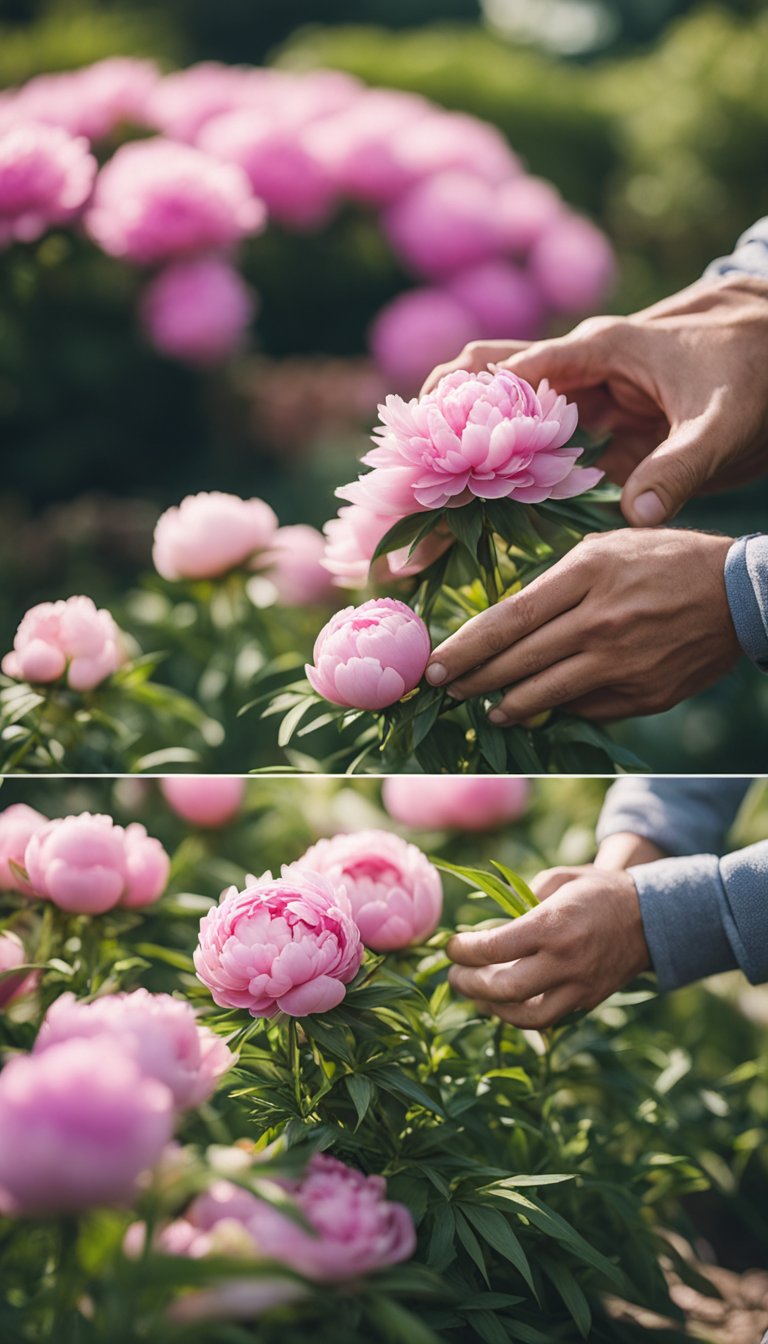Transplanting peonies in spring can be a rewarding experience for any gardener. Peonies are known for their vibrant colors and sweet fragrances, making them a popular choice for gardens and landscapes.
This post may contain affiliate links.
If you are looking to move your peonies to a new location or simply want to give them a fresh start, spring is the perfect time to do so.
When transplanting peonies, it is important to choose the right location. Peonies prefer well-draining soil and full sun, so make sure to select a spot that meets these requirements.
Spring is an ideal time to transplant peonies because the soil is moist and temperatures are mild, giving the plant time to establish its roots before the heat of summer sets in. By following a few simple steps, you can ensure that your peonies thrive in their new home.
Understanding Peony Transplanting
If you are considering transplanting your peonies, it’s important to understand the best time to do so and the reasons for doing it. Here’s what you need to know.
The Best Time to Transplant Peonies
The best time to transplant peonies is during their dormant season, which is typically in the fall or early spring. However, if you missed the fall season, spring is still a viable option.
It’s important to transplant your peonies before they start to grow new shoots, as this can damage the plant and reduce its blooms.
Mixed Peony Value Bag (3 Pack) – Freshly Dug Peony Flower Bulbsover Detergent Booster for Clothes
Reasons for Transplanting Peonies
There are a few reasons why you might want to transplant your peonies. One common reason is if they are not getting enough sunlight in their current location.
Peonies need at least six hours of sunlight per day to thrive. Another reason is if they are overcrowded and need more space to grow. If your peonies are not blooming as much as they used to, this could also be a sign that they need to be transplanted.
When transplanting your peonies, be sure to dig up the entire root system and replant them in a new location with well-draining soil.
It’s also a good idea to add compost or other organic matter to the soil to help your peonies establish themselves in their new home.

Preparing for Transplantation
Before transplanting your peonies, it’s important to take the necessary steps to ensure their success. This includes selecting the right location, preparing the soil, and gathering the necessary tools.
Selecting the Right Location
When selecting a new location for your peonies, choose a spot that receives full sun for at least six hours a day. This will help your peonies grow strong and healthy. Make sure the area has good drainage to prevent water from pooling around the roots.
Soil Preparation
Peonies prefer well-draining soil that is rich in organic matter. Before transplanting, amend the soil with compost to improve its texture and fertility. Use a spade to loosen the soil to a depth of at least 12 inches.
Gathering Necessary Tools
To transplant your peonies, you will need a few tools. A spade or sharp knife will be needed to dig up the existing plant. You may also need a wheelbarrow or bucket to transport the plant to its new location. Make sure your tools are clean and sharp to prevent damage to the plant.
By taking the time to prepare your peonies for transplantation, you can help ensure their success in their new location. Follow these simple steps to give your peonies the best chance at thriving in your garden.
The Transplanting Process
Transplanting peonies in spring is a great way to ensure they continue to thrive and produce beautiful blooms. The process involves digging up the peony, dividing the root ball, and planting the divisions. Here’s how to do it:
Digging Up the Peony
The first step in transplanting peonies is to dig up the plant. Begin by digging a wide hole around the plant, taking care not to damage the roots.
You should dig deep enough to get the entire root ball out of the ground. Once the root ball is exposed, gently lift the peony out of the hole and set it aside.
Dividing the Root Ball
After you have dug up the peony, it’s time to divide the root ball. Look for natural divisions in the root ball, which may be visible as separate sections or clumps.
Use a sharp knife or garden shears to divide the root ball into sections, making sure each section has at least three to five eyes.
Planting the Divisions
Once you have divided the root ball, it’s time to plant the divisions. Dig a wide hole for each section, making sure the hole is deep enough for the roots to be fully covered.
Place the section in the hole, making sure the eyes are facing up. Gently fill in the hole with soil, taking care not to damage the roots.
It’s important to water the newly transplanted peonies thoroughly after planting. This will help to settle the soil and encourage root growth. With proper care, your transplanted peonies should thrive and produce beautiful blooms for years to come.
Post-Transplant Care
Congratulations on successfully transplanting your peonies! Now that you have completed the transplanting process, it is important to provide proper care to ensure that your peonies thrive in their new location. Here are some tips for post-transplant care:
Watering and Mulching
Water your peonies immediately after transplanting to help them establish their roots in their new location. Make sure to water them deeply, so the water reaches the roots.
After the initial watering, continue to water your peonies regularly, especially during dry spells.
Mulching is also important for peonies, as it helps to retain moisture in the soil and suppress weed growth. Apply a layer of organic mulch around the base of your peonies, making sure not to cover the crown of the plant.
This will also help to regulate soil temperature, keeping the roots cool in hot weather and warm in cold weather.
Monitoring Growth and Health
Monitor the growth and health of your peonies regularly to ensure they are thriving in their new location. Keep an eye out for signs of pests, such as ants, which can damage peony buds. If you notice any pests, treat them immediately with an appropriate insecticide.
Check the soil moisture regularly to ensure your peonies are getting enough water. Peonies prefer well-draining soil, so make sure the soil is not waterlogged, which can lead to root rot.
Finally, make sure your peonies are getting enough sunlight. Peonies prefer full sun or partial shade, so make sure they are not in a location that is too shady. If your peonies are not getting enough sunlight, they may produce fewer flowers.
Common Challenges and Solutions
Transplanting peonies in spring can be a great way to give them a fresh start and ensure they continue to thrive in your garden. However, there are some common challenges that you may encounter during the process. Here are some solutions to help you overcome them.
Dealing with Pests and Diseases
One of the biggest challenges when transplanting peonies is dealing with pests and diseases. Powdery mildew is a common fungal disease that can affect peonies, causing leaves to turn yellow and brown.
To prevent powdery mildew, make sure your peonies are planted in well-drained soil and receive adequate air circulation. If you notice signs of powdery mildew, treat with a fungicide.
Another pest to watch out for is the peony borer. These small, black and yellow moths lay their eggs on the stems of peonies, which hatch into larvae that tunnel into the stems and cause damage.
To prevent peony borers, remove any affected stems and destroy them. You can also use insecticides to control the population.
Addressing Environmental Stress
Peonies can also experience environmental stress, especially during hot summers and winter dormancy. To prevent stress during hot summers, make sure your peonies receive adequate water and shade.
During winter dormancy, protect your peonies from extreme cold temperatures by covering them with mulch or a frost blanket.
In addition, make sure your peonies are planted in well-drained soil to prevent waterlogged roots, which can lead to root rot and other diseases. If you notice signs of stress, such as wilting or yellowing leaves, address the issue promptly by providing the necessary care and treatment.
Frequently Asked Questions
What is the best season to move peonies to a new location?
Spring is the best time to transplant peonies. This is because the plants are just starting to grow and have not yet formed their new buds. Moving them in the fall can cause them to go into shock and not bloom the following season.
How can I prevent transplant shock in peonies after moving them?
To prevent transplant shock, water the peonies well several days before transplanting. This will help the roots hold onto the soil and reduce the risk of damage during the move. After transplanting, water the plants regularly for the first few weeks to help them establish in their new location.
Is it possible to successfully transplant peonies into containers?
Yes, it is possible to transplant peonies into containers. Choose a container that is at least 18 inches wide and deep, and fill it with a high-quality potting mix.
Place the peony in the container and water it well. Keep the soil moist and place the container in a location where it will receive at least six hours of sunlight each day.
What are the steps for properly transplanting peonies?
First, prepare the new location by digging a hole that is twice as wide and deep as the peony’s root ball. Next, dig up the peony, being careful not to damage the roots.
Place the plant in the new hole and backfill with soil, making sure the plant is at the same depth as it was in its original location. Water the plant well and add a layer of mulch around the base to help retain moisture.
How long does it take for peonies to bloom after being transplanted?
It may take one to two years for peonies to bloom after being transplanted. This is because the plant needs time to establish its roots in its new location. Be patient and continue to care for the plant, and it will reward you with beautiful blooms in the future.
What care should be taken when moving peonies in different hardiness zones?
If you are moving peonies to a different hardiness zone, make sure the new location is suitable for the plant’s needs. Peonies prefer full sun and well-draining soil.
If you are moving to a colder zone, make sure to plant the peony deeper than it was in its original location to protect it from frost. If you are moving to a warmer zone, make sure to provide some shade during the hottest part of the day to prevent the plant from getting too hot.
Follow my gardening board on Pinterest.




